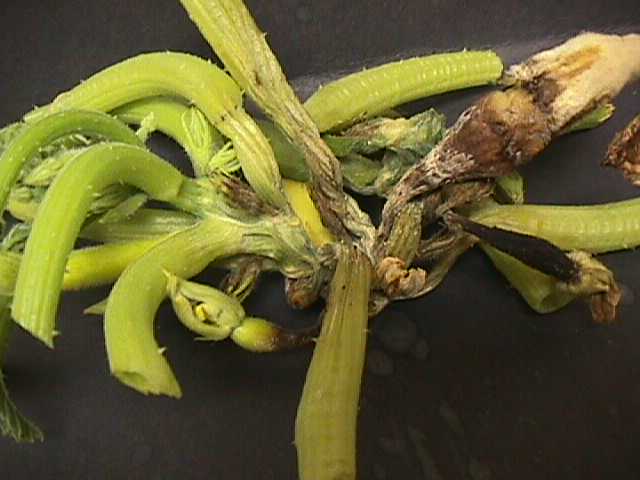Phytophthora crown rot on cucurbits and peppers requires an aggressive approach
This pathogen swims and enjoys wet conditions.

This year’s wet conditions are just what Phytophthora ordered. This plant pathogen lives in the soil and survives Michigan winters. It does not move via air currents but spreads via splash of contaminated soil, surface water such as culverts, rivers, creeks and streams contaminated by run-off from infested fields, and the dumping of diseased culls onto production fields. Phytophthora is especially unique because it can develop a swimming spore when the soil becomes saturated. The swimming spores move across a field in a pattern consistent with draining water and kills plants in its path (see fact sheet on Phytophthora and irrigation water). Squash, zucchini, pepper and pumpkin are especially susceptible. Plants that wilt and don’t recover can be a tell-tale symptom of this disease.
Phytophthora causing plant wilt and death for pepper, squash and zucchini has been reported across the state. The reports are not too surprising given the wet conditions and number of production sites with a history of contamination by this pathogen. The strategies that are needed to protect susceptible crops include applying fungicides to the plant’s root/crown zone via drip. Years of Michigan State University studies with pepper have shown the stark contrast between applying fungicides via drip versus a foliar application to the lower plant stem. In short, the plants receiving the fungicide through the drip lived, whereas the plants receiving a foliar application to the base of the stem did not. There was such a big difference between the ability of drenches to protect the plant versus foliar applications that foliar applications are not recommended for pepper.

In Michigan, there have been just a few instances of fruit rot occurring over the years, so the focus is entirely on keeping the plant healthy. There are some varieties of green bell peppers that have a good level of genetic resistance to Phytophthora. These cultivars are not immune from the disease, but they will stay healthy a lot longer than the varieties that do not have this resistance. (see fact sheet with fungicide management recommendations for Phytophthora on pepper).
Squash and pumpkin offer special challenges because both the plant and fruit are susceptible to Phytophthora. To keep the plants alive, applying fungicide through the drip is important and vastly more effective than overhead sprays to the foliage. In this way, managing Phytophthora on pepper and squash/pumpkin is similar. However, keeping the squash and pumpkin plants alive is only part of the battle. The second part of the disease management battle for squash and pumpkin is keeping the fruit alive even though it may be in close contact with contaminated soil. While the drenches keep the plant alive, they cannot protect the fruit. Only foliar applications of fungicides can protect the fruit and the fungicide sprays must be made so that they reach the fruit directly. If the canopy is dense, the fungicide spray may not reach the fruit, leaving it unprotected. Some growers have made adjustments and decreased the plant density to ensure their fungicide sprays are able to reach the fruit.

Recent studies from our lab show that hard squash is especially susceptible within the first three weeks of development and illustrates that these young fruits may need more protection than previously thought. For more information, see these fact sheets on fungicide management recommendations for winter squash and pumpkin and fungicide management recommendations for summer squash and zucchini. MSU research has also shown that green zucchini plants are less susceptible to Phytophthora than yellow summer squash. Acorn is also especially susceptible to crown and root rot compared to spaghetti squash.
Choosing effective fungicides is critical! Controlling this pathogen has been part of this lab’s field research for more than two decades. Keeping fungicide intervals tight and alternating effective products is an especially important to remember this season.
This material is based upon work that is supported by the National Institute of Food and Agriculture, U.S. Department of Agriculture, under award number 2015-51181-24285 and a Michigan Specialty Crop Block Grants administered by the Michigan Vegetable Council.



 Print
Print Email
Email

